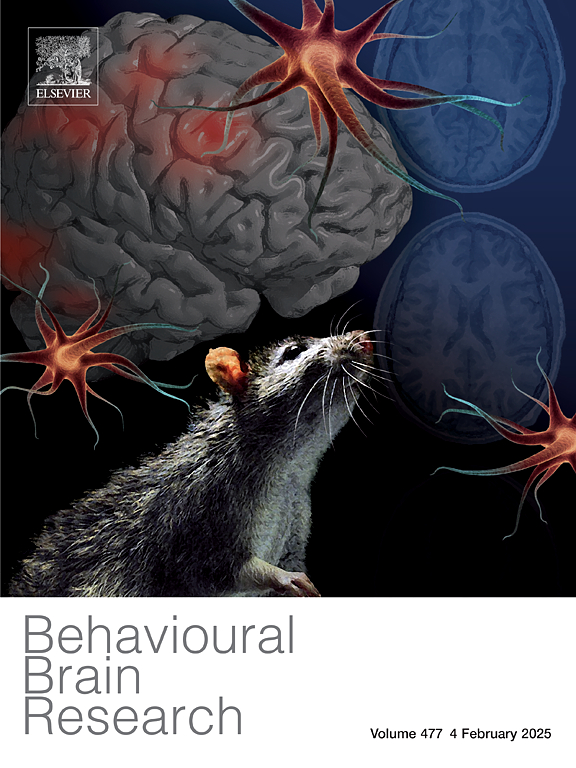Age-related effects on the association between alcohol use, severity and resting-state fMRI: A rat study comparing adolescent-onset and adult-onset drinking
IF 2.6
3区 心理学
Q2 BEHAVIORAL SCIENCES
引用次数: 0
Abstract
Adolescence is marked by neurodevelopmental changes that increase reward sensitivity, risk-taking, and behavioural control challenges, heightening the risk of alcohol use and dependence. Alcohol’s impact on resting-state functional connectivity (RSFC) may explain this risk, though comparisons to adulthood remain limited. This study examined age-related differences in the association between RSFC and alcohol use severity in rats that initiated low or high voluntary alcohol consumption during adolescence or adulthood. Forty-two male rats were selected based on their alcohol consumption levels after two months of exposure: adolescent (PND42) onset low (N = 12) and high drinking (N = 7) rats, and adult (PND77) onset low (N = 11) and high drinking (N = 12) rats. RSFC was measured 4–10 days after exposure ceased, and group-ICA identified networks. Permutation tests assessed associations between onset age and use severity on RSFC. Low drinking was associated with increased RSFC within the salience network compared to high drinking. High adolescent onset alcohol consumption was associated with increased Default Mode Network (DMN) connectivity relative to low use. Connectivity in this area was generally stronger in adult compared to adolescent onset groups. An age group effect was observed, with overall higher DMN-thalamic connectivity in adult versus adolescent onset rats. In conclusion, high adolescent alcohol use was associated with increased DMN connectivity compared to low use, potentially reflecting altered self-referential processing or withdrawal susceptibility in adulthood. In adult-onset rats, the observed increases in DMN and DMN-thalamic connectivity may reflect developmental differences rather than alcohol exposure. These findings highlight the need for further research on DMN connectivity and its role in AUD risk and resilience, particularly regarding adolescent alcohol use, and the inclusion of a control group without alcohol access to better isolate the effects of alcohol consumption.
年龄对酒精使用、严重程度和静息状态fMRI之间关系的影响:一项比较青少年和成年饮酒的大鼠研究
青春期的特点是神经发育的变化,这些变化增加了奖励敏感性、冒险精神和行为控制方面的挑战,增加了酒精使用和依赖的风险。酒精对静息状态功能连接(RSFC)的影响可以解释这种风险,尽管与成年期的比较仍然有限。本研究考察了在青春期或成年期开始低或高自愿饮酒的大鼠中,RSFC与酒精使用严重程度之间的年龄相关差异。选取42只雄性大鼠,根据其暴露两个月后的饮酒水平:青春期(PND42)发病低(N = 12)和高饮酒(N = 7)大鼠,成年(PND77)发病低(N = 11)和高饮酒(N = 12)大鼠。停止暴露后4-10天测量RSFC,组- ica识别网络。排列试验评估了发病年龄与RSFC用药严重程度之间的关系。与高饮酒量相比,低饮酒量与突出网络中RSFC的增加有关。与低饮酒相比,青少年高饮酒与默认模式网络(DMN)连通性增加有关。与青少年发病组相比,成人该区域的连通性通常更强。观察到年龄组效应,成年发病大鼠与青少年发病大鼠相比,dmn -丘脑的整体连通性更高。总之,与低酒精使用量相比,青少年高酒精使用量与DMN连通性增加有关,可能反映了成年后自我参照加工或戒断易感性的改变。在成年发病大鼠中,观察到的DMN和DMN-丘脑连通性的增加可能反映了发育差异,而不是酒精暴露。这些发现强调需要进一步研究DMN连通性及其在AUD风险和恢复力中的作用,特别是在青少年饮酒方面,并纳入一个没有酒精接触的对照组,以更好地隔离酒精消费的影响。
本文章由计算机程序翻译,如有差异,请以英文原文为准。
求助全文
约1分钟内获得全文
求助全文
来源期刊

Behavioural Brain Research
医学-行为科学
CiteScore
5.60
自引率
0.00%
发文量
383
审稿时长
61 days
期刊介绍:
Behavioural Brain Research is an international, interdisciplinary journal dedicated to the publication of articles in the field of behavioural neuroscience, broadly defined. Contributions from the entire range of disciplines that comprise the neurosciences, behavioural sciences or cognitive sciences are appropriate, as long as the goal is to delineate the neural mechanisms underlying behaviour. Thus, studies may range from neurophysiological, neuroanatomical, neurochemical or neuropharmacological analysis of brain-behaviour relations, including the use of molecular genetic or behavioural genetic approaches, to studies that involve the use of brain imaging techniques, to neuroethological studies. Reports of original research, of major methodological advances, or of novel conceptual approaches are all encouraged. The journal will also consider critical reviews on selected topics.
 求助内容:
求助内容: 应助结果提醒方式:
应助结果提醒方式:


